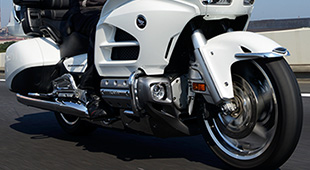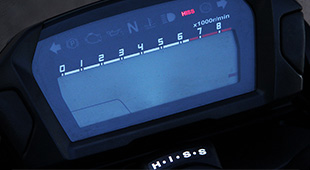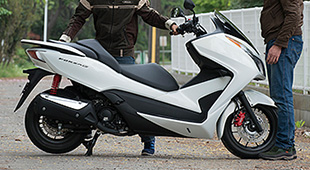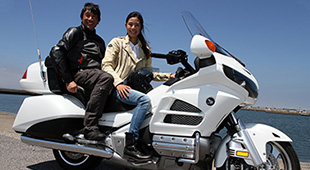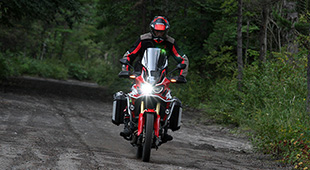Tech Views — Vol. 2 Advanced Brake Systems
Q&A
Honda's Advanced Brake Systems Q&A
Q1. What is the history of Honda's motorcycle brake system development?
A. From the perspectives of active safety and riding convenience, Honda has long focused on optimized braking performance as one of the most important elements of its research and development activities, and has devoted itself to the continuous evolution of braking systems. Efforts made to enhance basic technologies have even included the pursuit of front fork anti-dive geometry for improvements in handling stability when the brakes are applied, improvements in brake pad materials, and the early employment of dual-piston calipers. Developments related to such efforts can be summarized as follows:
- 1969: The world's first front disk brake for mass-production motorcycles introduced on the epoch-making CB750 Four. Early '70s: Research begins on a totally mechanical Antilock Brake System (ABS), including development of new hardware.
- 1983: Honda's first Combined Brake System is introduced on the GL1100 Gold Wing, simultaneously engaging both front and rear brakes with the application of the rear brake pedal.
- 1987: Development of a mechanical oil pressure control system for ABS completed.
- 1992: The first electronically-controlled Antilock Brake and Traction Control Systems developed exclusively for motorcycles introduced on the ST1100 Pan-European ABS+TCS sports tourer.
- 1993: Honda's first Dual-Combined Brake System, which engages both front and rear brakes when either the front brake hand lever or rear brake foot pedal, or both, are operated, introduced on the CBR1000F sports tourer.
- 1995: I ntegrated front and rear ABS introduced. M.A.C. ABS (Motor-Actuated Combined Antilock Brake System) for small bikes debuts on the 50cc Live Dio ST scooter.
- 1996: New ST1100 Pan-European introduced with the first-ever integrated Dual-Combined Brakes and ABS for large motor cycles.
- 1999: Lightweight, simplified Combi-Brake System debuts on 50cc Giorno Crea scooter. Left-side rear brake lever linked to both front and rear cable-actuated drum brakes.
- 2000s: Lineup of large and small motorcycles equipped with Combined-ABS greatly expanded.
- 2004: Plans announced to expand lineup of production motorcycles equipped with Honda's Advanced Brake Systems:"In the interests of promoting riding safety and convenience, by the end of 2007 Honda will begin equipping new models of over 250cc in displacement - including large scooters, sportsbikes and touring bikes - with Combined front and rear brakes and ABS in all our markets around the world. And by the end of 2010, all motorcycles larger than 250cc, except off-road models, will be equipped with advanced brake systems."
Q2. What is a Combined Brake System?
A. One of Honda's most important Advanced Brake Systems, this device automatically distributes an optimum balance of braking forces to both the front and rear wheels whenever the brake lever or brake pedal is applied. This system results in more stable motorcycle riding behavior under braking, and easily achieves an extremely high degree of braking response. Because of this, it enables riders to use both brakes to their full potential, providing an enhanced feeling of confidence and operating ease.
Q3. What is the Dual-Combined Brake System?
A. Another of Honda's Advanced Brake Systems, Dual-Combined Brakes are designed to distribute braking forces to both wheels whenever either the front or rear brake levers are used. Instead of applying equal braking force to both brakes, it modulates braking operation to emphasize the lever being used, in order to achieve a more stable distribution of braking forces.Developed to emphasize front wheel braking force when the front brake is used, and rear wheel braking force when the rear brake is used, this system greatly enhances riding and braking confidence for even those switching over from a conventional motorcycle brake system, and effectively achieves an optimal balance of braking performance with exceptional ease.
Q4. Since both the front and rear brakes of motorcycles equipped with the Combined Brake System are actuated if, for example, only the rear brake is operated, can front brake operation be omitted?
A. Operation of both the front and rear brakes in a well-balanced manner is a fundamental part of effective motorcycle brake operation. This is also true of motorcycles equipped with Honda's Combined Brake systems. With these systems, if, for example, only the rear brake pedal or front brake lever is applied, the resulting braking force is proportionally distributed to both wheels in an interlinked application. The system's proportional operation ensures that the majority of the braking force is applied to the front wheel when the front brake is used, and to the rear wheel when the rear brake is used.
However, while the Combined Brake System does engage both front and rear brakes when the rear brake pedal is used, optimal braking performance can only really be achieved when both front and rear brake levers are used by the rider to their full potential.
Q5. Are Honda's Combined Brake systems designed to shorten braking distances?
A. Motorcycle brake operation can differ widely depending on rider experience, road conditions, speed and other factors. One characteristic of Combined brakes is that their systems are designed to provide more of a sense of smooth stability than motorcycles not equipped with linked front and rear brakes, allowing riders to operate them with a greater degree of confidence and ease. Although not specifically designed to shorten braking distances, they do contribute significantly toward making it easier for a wider range of riders to confidently realize effective braking control and shorter stopping distances, regardless of experience and acquired riding technique.
Q6. What are the advantages of ABS?
A. When brakes are applied in an emergency situation, or on slippery road surfaces, if slippage should cause tire rotation to stop momentarily for any reason, this loss of traction could adversely affect the tire's ability to track where the driver intends to go. However, in the case of motorcycles, any loss of balance could lead to a fall and a potentially dangerous situation.
Additionally, any loss to a motorcycle's balance can make it extremely difficult to maintain optimal braking control. ABS is specifically designed to help tires achieve optimal deceleration and stopping performance while preventing them from exceeding their limits of grip, thus making it possible to maintain efficient and effective braking control over a wide variety of riding conditions. This further ensures a greater sense of confidence when brakes are applied in emergency maneuvers, or when operated on slippery roads.
Q7. Does ABS shorten braking distances?
A. In regards to braking distance, the limits of a tire's grip are determined by such factors as speed and road surface traction. ABS is not specifically designed to shorten braking distances, but is instead designed to maximize the braking capability of the tires. By extension, optimized braking capability can indeed result in shortened braking distances, but that was not the ultimate objective in developing the system.
Q8. Does ABS work well even while cornering?
A. The limits of grip are determined by the frictional forces at work between the tires and the road surface. When cornering, the lateral shear forces at work on a tire as it grips the road surface tend to increase sharply. Applying the brakes strongly enough at this time to engage the ABS could have a harmful effect on the maintenance of that grip, and subsequent control.
As with non-ABS motorcycles, the most efficient braking performance is achieved by braking and reducing speed while traveling in a straight line in an upright position before entering a turn.
- Top
- PCX
- Forza
- Gold Wing
- Q&A
- User Reviews

